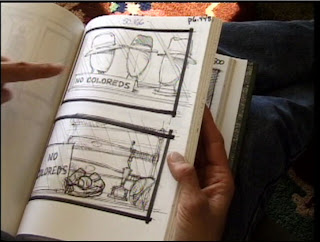Hi, my name is Debi and I’m a DVD addict.
One great resource for any sequential art buff are the DVD commentary and extras. Be forward though, there are great commentaries and there are horrible, horrible commentaries that make you want to hurl things at the TV while you scream ever curse word you know.
To help you all avoid that pain, here are some of the best of the best. All are chockfull of info and very entertaining. And feel free to add your favorite ones in the comments!
Suggested Commentaries:
X-Files, commentary by Kim Manners (Director/Producer)
He’s very technical and gets into what lens they used, lighting, and other camera equipment used.
Season 4:
"Max" (The X-Files Mythology, Volume 2 - Black Oil)
"Patient X" (The X-Files Mythology, Volume 3 - Colonization)
Season 6:
"Two Fathers" (The X-Files Mythology, Volume 3 - Colonization)
"Milagro" (The X-Files Season 6 DVD)
Season 7:
"Closure" (The X-Files Mythology, Volume 3 - Colonization)
Season 8:
"Existence" (The X-Files Season 8 DVD)
Season 9:
"The Truth" (The X-Files Season 9 DVD)
Buffy and Firefly, commentary by Joss Whedon (Director/Writer/Producer)
He’ll walk you through his decision-making process for scenes. He explains why he shot and wrote things the way he did. Great look inside his film making process.
Buffy:
Season 1
"Welcome to the Hellmouth"
"The Harvest"
Season 2
"Innocence"
Season 4
"Hush"
"Restless"
Season 5
"The Body" - (A must!)
Season 6
"Once More, With Feeling"
Season 7
"Chosen"
Firefly:
"Objects in Space" - (A must!)
Supernatural, commentary by Eric Kripke (Director/Writer/Producer)
Like Joss’s commentary, his passions and knowledge of the medium oozes out of his commentary. It’s a joy to listen to. He also goes over a lot of his decision-making process about his shots.
Season 2:
“What It Is and What Should Never Be”
Season 4:
“Lucifer Rising”
Farscape, Commentary by Ben Browder, Claudia Black, Rockne O’Bannon, and David Kemper
While this is my all time favorite show, this commentary is special because it’s not about how good the episode was, but rather, about how everything went wrong! They even titled the commentary “When Bad Things Happen to Good Shows”. It’s great to hear how bad decisions were made and how they piled up.
Season 1:
"Jeremiah Crichton"
Suggested Extras:
Pleasantville: The Art of Pleasantville, The Storyboards: An extra shows you the books they made from all the storyboards in the film. Director of photography, John Lindley flips through the books while talking all about the boards and the process. The commentary with director Gary Ross is also great on this film.





































